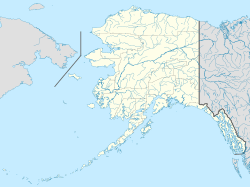Brevig Mission, Alaska facts for kids
Quick facts for kids
Brevig Mission
Sitaisaq (Inupiaq)
|
|
|---|---|

Brevig Mission in 2017
|
|
| Country | United States |
| State | Alaska |
| Census Area | Nome |
| Incorporated | October 6, 1969 |
| Area | |
| • Total | 2.51 sq mi (6.51 km2) |
| • Land | 2.43 sq mi (6.30 km2) |
| • Water | 0.08 sq mi (0.21 km2) |
| Elevation | 16 ft (5 m) |
| Time zone | UTC-9 (Alaska (AKST)) |
| • Summer (DST) | UTC-8 (AKDT) |
| ZIP code |
99785
|
| Area code | 907 |
| FIPS code | 02-08740 |
| GNIS feature ID | 1420670 |
Brevig Mission is a small city in Nome Census Area, Alaska. Its name in the Inupiaq language can be Sitaisaq, Sitaisat, or Sinauraq. In 2010, about 388 people lived there.
The city is named after Tollef L. Brevig. He was a Norwegian Lutheran pastor who worked at a mission in the area. The place was first settled in 1900 and was known as Teller Mission. Later, it was renamed Brevig Mission. Most people living here are Inupiat Eskimo. They continue to live by subsistence, which means they get most of their food and supplies directly from nature. Brevig Mission is also a dry village. This means it is against the law to sell or have alcohol there.
Contents
Where is Brevig Mission?
Brevig Mission is located in Alaska at coordinates 65.334235 degrees north and -166.492952 degrees west.
The city covers a total area of about 2.6 square miles (6.5 square kilometers). Most of this area is land, and a small part is water.
People Living in Brevig Mission
| Historical population | |||
|---|---|---|---|
| Census | Pop. | %± | |
| 1950 | 109 | — | |
| 1960 | 77 | −29.4% | |
| 1970 | 123 | 59.7% | |
| 1980 | 138 | 12.2% | |
| 1990 | 198 | 43.5% | |
| 2000 | 276 | 39.4% | |
| 2010 | 388 | 40.6% | |
| U.S. Decennial Census | |||
Brevig Mission first appeared in the U.S. Census in 1950. It was called "Teller Mission" back then. In 1969, it officially became a city and changed its name to Brevig Mission.
In the year 2000, there were 276 people living in the city. About 90% of the people were Native American. The rest were mostly White or from two or more racial backgrounds.
Many households in Brevig Mission had children under 18 living with them. The average household had about four people. The median age of people in the city was 20 years old.
Schools in Brevig Mission
The Bering Strait School District serves Brevig Mission. Students in grades Pre-K through 12 attend Brevig Mission School.
The 1918 Flu Pandemic
The 1918 flu pandemic was a very serious illness that spread around the world. It caused many deaths in a short time. In Brevig Mission, this flu was especially devastating. It sadly killed 72 out of 80 residents in just five days. These 72 people were buried together in a large grave. This grave was dug in the frozen ground by gold miners and is marked by white crosses.
Alaska Natives had no natural protection against this new flu. This meant the illness spread quickly and affected many villages very badly.
Years later, in 1997, a team of scientists studied the remains of an Iñupiat woman. She had been buried in the frozen ground near Brevig Mission. The scientists were able to find parts of the 1918 flu virus in her body. This helped them learn more about the virus that caused the pandemic.
Images for kids
See also
 In Spanish: Brevig Mission (Alaska) para niños
In Spanish: Brevig Mission (Alaska) para niños



